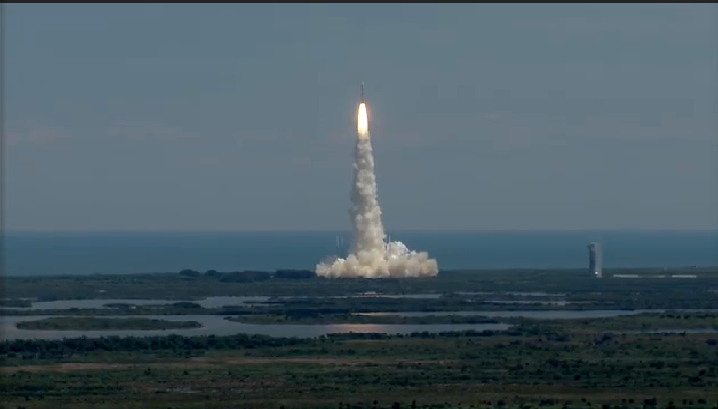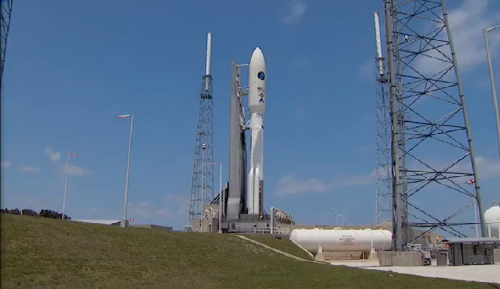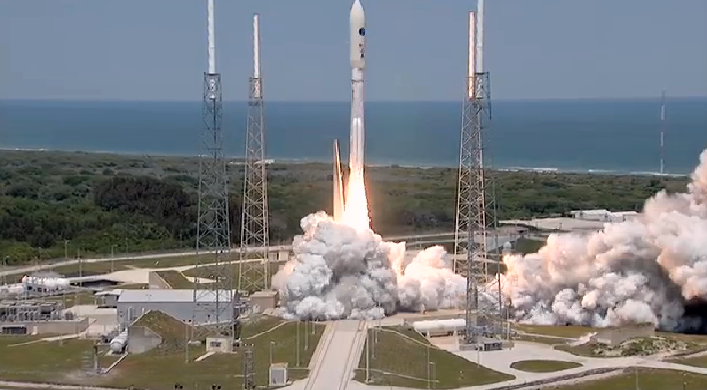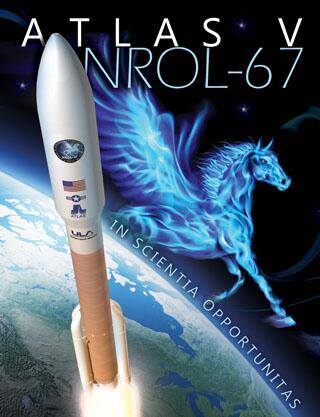
The Eastern Range has returned to flight operations, following a recent fire which impacted a radar tracking asset and forced the postponement of a critical mission for national defense and a cargo delivery flight to the International Space Station (ISS). At 1:45 p.m. EDT Thursday, 10 April, right on the opening of a 41-minute “window,” United Launch Alliance (ULA) successfully staged its 81st mission since the company was founded back in December 2006. The mission, which utilized the second-most-powerful active version of the Atlas V launch vehicle—the “541,” equipped with a 17.7-foot-diameter (5.4-meter) payload fairing, four strap-on solid-fueled boosters, and a single-engine Centaur upper stage—was tasked with delivering the classified NROL-67 payload into orbit on behalf of the National Reconnaissance Office.
Today’s launch occurred from Space Launch Complex (SLC)-41 at Cape Canaveral Air Force Station, Fla. Last month, a fire at the TEL-4 Telemetry Processing Facility site, part of the Cape’s Eastern Space and Missile Center (ESMC), caused significant damage to a crucial radar tracking asset. “Inspections conducted by the U.S. Air Force that operates the Eastern Range and all of its assets revealed that extensive equipment replacements were needed to bring the radar station back online,” explained Spaceflight101, “a process that would take weeks, because there no backup components were available and had to be ordered to the Cape before being installed.” In response to the likelihood of a lengthy delay in its tight schedule of launches from the Cape—which will also shortly support SpaceX’s third dedicated Dragon cargo mission (CRS-3) to the ISS—the Air Force and ULA were obliged to identify “an alternate solution using other Range assets.” It was noted that since the classified NROL-67 mission was on the range first, it was granted the first launch opportunity, whereas SpaceX opted for a “window” between 14-18 April in order to achieve favorable phasing for Dragon’s rendezvous with the ISS.
At the final Launch Readiness Review on Tuesday, 8 April, ULA formally declared that it was “Go” for the NROL-67 launch. Atop its Mobile Launch Platform (MLP), the 19-story Atlas V 541 stack departed the Vertical Integration Facility (VIF) and was rolled 0.3 miles (480 meters) north to Space Launch Complex (SLC)-41 yesterday (Wednesday). According to Patrick Air Force Base meteorologists, weather conditions were anticipated to be 90-percent favorable at launch time, with “thick cloud” identified as the principal concern. The vehicle was “hard down” on the pad surface about 7.5 hours ahead of the opening of the launch window, after which engineers set to work establishing electrical and fluid connections and performing flight control system checks and weather briefings.

At 6:45 a.m. EDT, some seven hours before the opening of the launch window, formal countdown operations got underway as flight controllers were called to stations, and the Atlas V vehicle was activated at T-6 hours and 20 minutes. This was followed by electrical and fluid connections, tests of the rocket’s S-band and C-band communications systems, and checks of the Flight Termination System (FTS), which was tasked with destroying the Atlas in the event of a major accident during ascent. By T-3 hours, all personnel had been evacuated from the SLC-41 area.
Shortly after 11 a.m. EDT, the countdown was halted, as intended, for a 30-minute built-in hold, preparatory to a pre-fueling briefing and formal authorization to begin loading propellants aboard the vehicle’s Common Core Booster (CCB) and the Centaur upper stage. The authorization was granted just before 11:40 a.m. EDT. “The process starts with a chill-down of the booster and Centaur tanks, followed by a similar chill-down of the ground pipes and control valves,” explained AmericaSpace’s Launch Tracker. “This prevents any damage to delicate components from thermal shock as the super-cold propellants are introduced into the system.” Liquid oxygen was first to be transferred into the Centaur’s tanks, and as oxidizer was flowing, at 12:00 p.m. EDT, the process to chill the upper stage’s hydrogen fuel lines got underway. Liquid oxygen reached flight levels aboard the Centaur and entered a so-called “topping” mode at T-64 minutes. Meanwhile, the operation to fuel the CCB with liquid oxygen and a highly refined form of rocket-grade kerosene (known as “RP-1”) got underway at 12:10 p.m. EDT, proceeding smartly through its Slow Fill, Fast Fill, and Topping stages. The final cryogenic propellant to be loaded was liquid hydrogen into the Centaur, which reached its topping level by T-40 minutes.
By 1 p.m. EDT, all cryogenic fuel systems were confirmed as almost full and had transitioned into the topping mode, whereby any boiled-off oxygen or hydrogen was replenished to ensure that the tanks remained at flight levels. A steady plume of gases could be seen emanating from the Atlas V during this period, formed by the boiling-off of propellants. The final weather briefing was conducted at 1:25 p.m. EDT and produced a definitive “Go for Launch.” With all tanks confirmed at flight levels, the final checkout of the FTS was performed and the ascent software, based upon the real-time weather situation on the Florida coast, was updated. The vehicle entered the second built-in hold in the countdown, scheduled to last 10 minutes, at the T-4 minute mark at 1:31 p.m. EDT. At the end of the hold, following a “Go/No-Go” poll of all stations—which produced a unanimous “Green” status (“Go for Launch”)—the terminal countdown commenced at 1:41 p.m. EDT. The vehicle was transferred to internal power, and, 60 seconds ahead of liftoff, the Launch Control System was enabled and the Atlas’ computers assumed primary command of all critical functions. The final Range status call produced a clipped “Range Green” response.

Two and a half seconds before liftoff, the rocket’s Russian-built RD-180 first stage engine—fueled by liquid oxygen and RP-1—roared to life, spooling up to its full 860,000 pounds (390,000 kg) of thrust by T-0 and producing a crackling, on-time liftoff at 1:45 p.m. EDT. Climb-out of the stack from SLC-41 got underway at T+1.1 seconds. Shortly after clearing the tower, the vehicle executed a combined pitch, roll, and yaw program maneuver to position it onto the proper flight azimuth to inject its NROL-67 primary payload into orbit. A little over a minute into the flight, with the RD-180 still burning hot and hard, the rocket burst through the sound barrier, at which point maximum aerodynamic stresses (known as “Max Q”) were experienced through the Atlas’ airframe.
In response to this aerodynamic situation, the RD-180 was temporarily throttled back to 95 percent of its rated performance. Two minutes into the flight, the four strap-on boosters were jettisoned, as planned, leaving the CCB alone to continue the push toward orbit. Catering for the requirements of their “customer,” the National Reconnaissance Office, ULA announced in their live webcast that they would be ending their coverage at T+3 minutes, just after the payload fairing had been jettisoned. “This is standard operating procedure from the National Reconnaissance Office,” explained AmericaSpace’s Launch Tracker, “where they use a number of tracks and deceptions in an attempt to disguise the orbital insertion of the NROL spacecraft.” The RD-180 engine shut down about four minutes and 21 seconds after launch, and, following the separation of the first stage, the turn came for the Centaur, which carried the key responsibility of boosting NROL-67 into orbit. The Centaur’s RL-10A engine, built by Pratt & Whitney, is capable of restarting in flight, although the number of “burns” it will perform to deliver its classified payload remains unknown.

Also unknown is the precise nature of NROL-67. According to ULA Launch Commentator Danielle Taylor, the payload was named in honor of the late John “Austin” Wheeler of the National Reconnaissance Office. A clue to its nature may be derived from the use of the heavy-lift Atlas V 541, which has the potential to boost a payload weighing up to 38,455 pounds (17,443 kg) into low-Earth orbit or up to 18,276 pounds (8,290 kg) into geostationary transfer orbit. Before today’s launch, the 541 had been used only once in the history of the Atlas V; back in November 2011, it carried NASA’s Mars Science Laboratory (MSL) and the Curiosity rover on the opening leg of their voyage to the Red Planet.
As for NROL-67, it can be expected that amateur and professional satellite-spotters will have identified it in orbit, and this may provide a clearer indication of its possible mission objectives. Low-Earth orbit and geosynchronous orbit have both been suggested, but Spaceflight101 pointed out that in the former case, due to the large payload capability of the Atlas V 541 to low-Earth orbit, which equates to more than 17 metric tons, “there is no candidate satellite that would match these criteria.” It was also stressed that the recent Notice to Airmen and Mariners (NOTAM) may be indicative of a direct-ascent trajectory into geosynchronous orbit or highly-elliptical “Molniya orbit,” or even that NROL-67 represents an entirely new kind of reconnaissance or Electronic Intelligence (ELINT) satellite.
The Atlas V has one of the most reliable track records of any operational launch vehicle in the world today, having flown its 43rd outright successful mission from Vandenberg Air Force Base, on 3 April, to deliver the Defense Meteorological Satellite Program (DMSP)-19 military weather satellite into orbit. Since its maiden voyage, back in August 2002, it has suffered just one partial failure, a premature Centaur shutdown in June 2007, which inserted a pair of ocean surveillance satellites into a lower-than-planned orbit. Today, with its 44th successful launch out of 45 in total, it has continued to maintain what ULA describes as “Perfect Product Delivery” and has secured its reliability percentage of mission success at almost 97.8 percent.
Want to keep up-to-date with all things space? Be sure to “Like” AmericaSpace on Facebook and follow us on Twitter: @AmericaSpace
Missions » NROL » NROL-67 »


